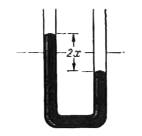Water meniscus in a glass tube is concave while that of mercury is convex. Why ?
To understand why the meniscus of water in a glass tube is concave while that of mercury is convex, we need to consider the concepts of cohesive and adhesive forces.
1. Define Cohesive and Adhesive Forces:
- Cohesive Forces: These are the intermolecular forces that hold the molecules of the same substance together. In liquids, this leads to surface tension.
- Adhesive Forces: These are the intermolecular forces that occur between different substances. For example, the forces between water molecules and the molecules of the glass.
2. Behavior of Water in a Glass Tube:
- When water is placed in a glass tube, the adhesive forces between the water molecules and the glass are stronger than the cohesive forces among the water molecules themselves.
- As a result, the water molecules are attracted to the glass, causing the water to "climb" up the sides of the tube, creating a concave meniscus.
3. Behavior of Mercury in a Glass Tube:
- In contrast, when mercury is placed in a glass tube, the cohesive forces between mercury molecules are stronger than the adhesive forces between mercury and the glass.
- This causes the mercury to pull away from the glass, resulting in a convex meniscus.
4. Conclusion:
- The shape of the meniscus (concave for water and convex for mercury) is determined by the relative strengths of cohesive and adhesive forces.
- For water, adhesive forces dominate, leading to a concave shape, while for mercury, cohesive forces dominate, leading to a convex shape.
Summary:
- Water has a concave meniscus in a glass tube due to stronger adhesive forces compared to cohesive forces.
- Mercury has a convex meniscus in a glass tube due to stronger cohesive forces compared to adhesive forces.
- Cohesive Forces: These are the intermolecular forces that hold the molecules of the same substance together. In liquids, this leads to surface tension.
- Adhesive Forces: These are the intermolecular forces that occur between different substances. For example, the forces between water molecules and the molecules of the glass.
- When water is placed in a glass tube, the adhesive forces between the water molecules and the glass are stronger than the cohesive forces among the water molecules themselves.
- As a result, the water molecules are attracted to the glass, causing the water to "climb" up the sides of the tube, creating a concave meniscus.
- In contrast, when mercury is placed in a glass tube, the cohesive forces between mercury molecules are stronger than the adhesive forces between mercury and the glass.
- This causes the mercury to pull away from the glass, resulting in a convex meniscus.
- The shape of the meniscus (concave for water and convex for mercury) is determined by the relative strengths of cohesive and adhesive forces.
- For water, adhesive forces dominate, leading to a concave shape, while for mercury, cohesive forces dominate, leading to a convex shape.
- Water has a concave meniscus in a glass tube due to stronger adhesive forces compared to cohesive forces.
- Mercury has a convex meniscus in a glass tube due to stronger cohesive forces compared to adhesive forces.
Similar Questions
"The shape of water meniscus is concave, whereas the shape of mercury menisscus is convex" Why?
View Solution"The angle of contact of mercury with glass is obtus, while the water with glass is acute." Why?
View SolutionAn open capillary tube is lowered in vessel with mercury. The difference between the levels of the mecury in the vessel and in the capillary tube △h=4.6mm. What is the radius of curvature of the mercury meniscus in the capillary tube? Surface tension of mercury is 0.46N/m, density of mercury is 13.6gm/cc.
View SolutionWater rises up in a glass capillary upto a heigh 10 cm, while mercury falls down by 3.5 cm in the same capillary. If the angles of contact for water-glass and mercury-glass are taken as 0∘ and 135∘ respectively, compare the surface tensions of water and mercury. [Given density of water = 103 kg m−3, density of mercury = 13.6 ×103 kg m−3]
View SolutionWater on a clean glass surface, tends to spread out, while mercury on the same surface, tends to form drops. Why?
View SolutionA cup contains some mercury in it. Now a narrow glass tube is lowered in the mercury. After some time the mercury level in the tube becomes lower than the mercury level outside the tube as shown in diagram. During this process (Choose correct statements)

View SolutionMercury fills a glass tube Fig. so that the total column is 20 cm long. The tube is then rocked, so that the mercury begins to oscillate. Find the frequency and the period of the vibrations.

View SolutionTwo identical glass spheres filled with air are connected by a thin horizontal glass tube the glass tube contains a pellet of mercury at its mid-point Air in one sphere is at 0∘C and the other is at 20∘C if temperature of both the vessels are increased by 10∘C then neglecting the expansions of the bulbs and the tube
View SolutionWater rises up in a glass capillary upto a height of 9.0cm, while mercury falls down by 3.4cm in the same capillary. Assume angles of contact for water glass and mercury glass 0∘ and 135∘ respectively. Determine the ratio of surface tension of mercury and water (cos135∘=−0.71).
View SolutionAssertion :The contact angle between water and glass is acute.
Reason :The surface of water in the capillary is convex .
View Solution
